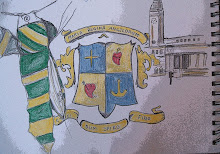Here are the final designs for my pictograms, in both black and white and the version with colour. In terms of the colour use, I decided to use pastel colours so that it was not too bright and bold but subtle colours. I wanted to use a different colour for each department to add distinction to each one, which I think is particularly useful for the subjects, which are homed in the same buildings on campus, to avoid the confusion that they are not part of the same department in terms of subjects. Some colours add to the clarity and understanding of the symbols, which I think has been beneficial for the communication of the departments. For Japanese, I have incorporated the flag into the design. The colour red had been used to highlight this, which I think works well in communicating that the subject is Japanese.
I have tried to make the set as unified as possible in terms of the design of the symbols representing each subject. I have used both straight and curved lines to bring depth and more of a quality to the designs, which can be seen through the progress of my development. I think this combination of curved and straight edges has made them look more professional particularly as they developed from the initial ideas.
For each of the subjects, I found some much easier to communicate in terms of the choice of symbol to show the subject. However, there were some that were slightly more difficult to represent, including Spanish and also Design. For design I started off with the initial ideas of having a Mac computer as well as a pallet and paintbrush but this did not fit very well with the set having simply one symbol for each. I found this quite tricky trying to think of a single symbol that communicated design as a whole because of the many different aspects of it like graphics, fashion, product as well as art and design. I managed to come up with various tools that are associated with different design subjects, such as a pencil, paintbrush as well as a scalpel and this is the idea I went with. I tried to keep the designs as simple as possible so that the communication was clear to the audience.




























